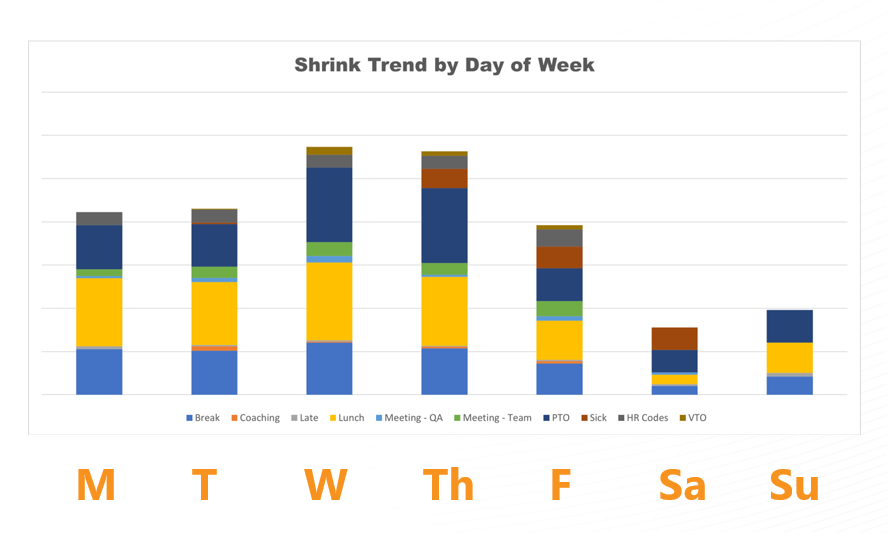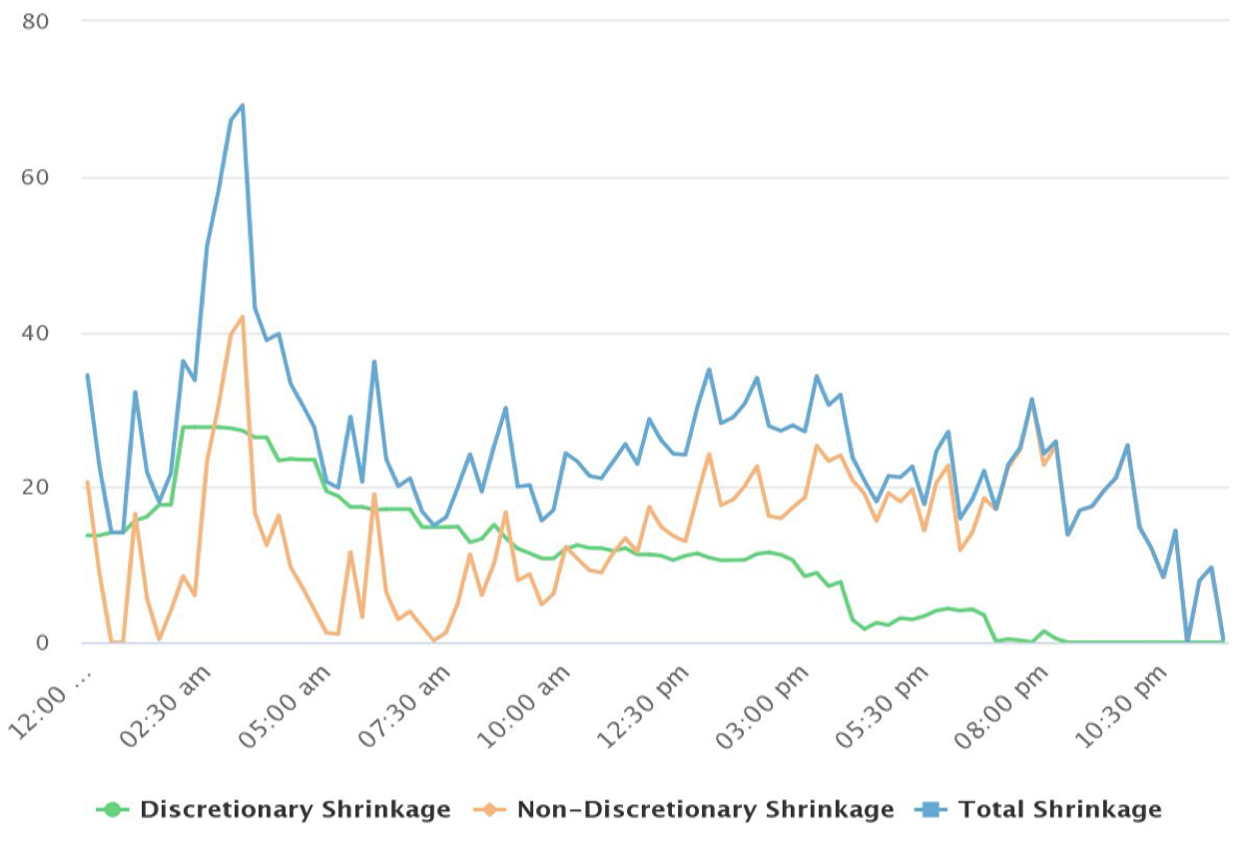
If you have ever worked in a retail or contact center environment, you may have heard the term “shrinkage” used from time to time. Today it’s time for a deeper dive into the evolution of shrinkage in the contact center.
What exactly does contact center shrinkage mean?
The word shrinkage in a business setting originated many years ago as a way for retailers to refer to their lost, stolen, or damaged merchandise. Shrinkage directly correlated to what percentage of their product was not purchased and thus wouldn’t be contributing to their revenue.
In the contact center world, the shrinkage term has a similar meaning but instead of loss being attributed to a product, it’s the time of an agent that is being impacted. To put it simply, shrinkage in a contact center means any time an agent isn’t available to complete a new piece of work, such as answering a phone call or responding to a chat message. This is lost time to a contact center because an agent isn’t able to help customers as intended in their role with the company. Shrinkage examples include training, company events, and more. Modern contact center workforce management software is used by many companies to broadly work through shrinkage.
What does shrinkage actually show?
The real reason contact centers care about shrinkage is that the term has become a vital key performance indicator of healthy operations.
If you’re a contact center, ask yourself the following questions…
- Are agents feeling overwhelmed?
- Are there things happening that we as management may miss due to operational blindness or tunnel vision?
- Are there trends that we need to be aware of as we plan out our days
- Is there a lot of discretionary shrinkage in comparison to non-discretionary? (we will cover this later on if you are unsure)
If you answered yes to several of these questions, you likely can improve how your contact center works through shrinkage and improve the overall productivity and morale of your contact center.
How is shrinkage currently calculated?
The math behind shrinkage has evolved over time but is now pretty straightforward.
When calculating shrinkage, remember that you are looking to determine the total staff required to ensure you will always have the minimum number of staff needed based on your contact volume and other factors (such as maintaining service levels).
How to calculate shrinkage
Total hours not working / Total scheduled paid hours
Example: 30 hours not working / 100 scheduled hours = 30%
How to determine required base staff
Total Required Staff – (Total Required Staff * Shrinkage %)
Example: 100 – (100 * 30%) = 70 Required Base Staff
How to calculate total staff required
Required Base Staff / (1 – Shrinkage %) = Total Staff Required
Example: 70 / (1 – 30%) = 100
These three equations will get you on your way to effectively managing the shrinkage of your contact center.
The different shrinkage types
Earlier we brought up two different types of shrinkage. Below is a quick definition of discretionary (planned) or non-discretionary (unplanned) terms and why they matter.
- Discretionary shrinkage is also commonly referred to as planned shrinkage and encompasses those things that are within our control (meetings, trainings, etc.). These are events a contact center can control.
- Non-discretionary shrinkage is also commonly referred to as unplanned shrinkage and encompasses those things that are outside of our control (absenteeism, HR protected events, etc.). A contact center really doesn’t have much control over this type of shrinkage, it’s just what needs to happen being a part of a company.
Now, let’s take a look at a quick shrinkage example from a contact center in the image below…

Based on this information, we can break out the shrinkage into a bucket for each type.
Discretionary (8.8% total)
- 7% meetings/training
- 2% personal enrichment
- 9% prescheduling time off
Non-discretionary (16% total)
- 3% tardiness
- 4% absenteeism
- 5% HR codes (bereavement, family leave, etc.)
- 8% breaks and lunch
In the next section we can take this data and use the equations outlined earlier to complete a shrinkage calculation.
What actual shrinkage figures look like
Running the information from the previous section through the equations, and assuming we are looking for a base agent requirement of 50, we get the following information…
- Discretionary shrinkage total = 8.8%
- Non-discretionary shrinkage total = 16%
- Total shrinkage = 8%
What does this mean? Given the base agent requirement (50) and the shrinkage (24.8%) a contact center would need to staff 66 agents to ensure its operations are running smoothly and effectively. Having an additional 16 agents would enable a contact center to reliably stay at or above the 50 working agent threshold throughout the day.
Why you can’t trust shrinkage alone
Just because, after doing the math, you get 66 agents it doesn’t mean that it’s time to staff this number of agents. A contact center should always factor in something else – trends – into their forecasting and scheduling decisions.
Ask yourself the following questions after you’ve completed shrinkage calculations to determine if any additional staffing adjustments need to be made.
- Do we have a higher percentage of shrink certain days, weeks, months, than others?
- Is there a correlation that we can identify based on past experiences?
- Do we need to increase our opening staff to account for X?
- Example: inclement weather overnight for an insurance contact center
- Do we need to review middle of the day to factor in Y?
- Example: new product announcement by the marketing team in the late morning
Factoring in trends lets you take a great starting point in knowing your shrinkage and provides insights to improve upon it. Sometimes looking at historical shrinkage can show trends as well, such as if there is a spike in both call volume and discretionary shrinkage during a specific holiday. As you can see below from WFM software reporting, sometimes shrinkage can vary by the day of the week as well.

Time of day can also be a factor in shrinkage too...

Making shrinkage data actionable
Having information about shrinkage is nice… but how can it be applied? Take a look at the statement below, created based on all the information above, and see if it accurately describes the shrinkage scenario for the contact center.
“Last month we observed a 25% shrink on the floor so we need to take that into account when we do staff planning for the coming months. Some of that was what we call discretionary (planned) shrinkage, so we may be able to mitigate some impact, but we also had a decent amount of non-discretionary (unplanned) shrinkage to account for.”
While it’s not a bad statement and the facts are right, the findings are a bit surface level. See below for a statement that has more detail when you factor in trends and can improve contact center operations even further.
“Last week we observed a 38% shrink on the floor with a noted upswing in the early morning due to tardies and some overnight people leaving early. Looking at previous weeks it looks like this may be a trend that we need to address when we do schedules for the coming weeks.”
Not only does the second statement come across as more actionable, but it sounds better too!
Final thoughts on contact center shrinkage
To summarize everything, what tracking shrinkage does is let contact centers quantify behaviors and trends to accurately manage and maintain an optimized and successful workforce. Tracking shrinkage provides information about the “shadow work” happening in a contact center which helps to make sure an environment is being accurately built that anticipates the real existing needs.
Shrinkage will continue to remain a key information point for contact centers to monitor both now and in the future to keep agents happy and operations running smoothly. AI workforce management software will continue to be critical for contact centers looking to have success with tracking shrinkage.








